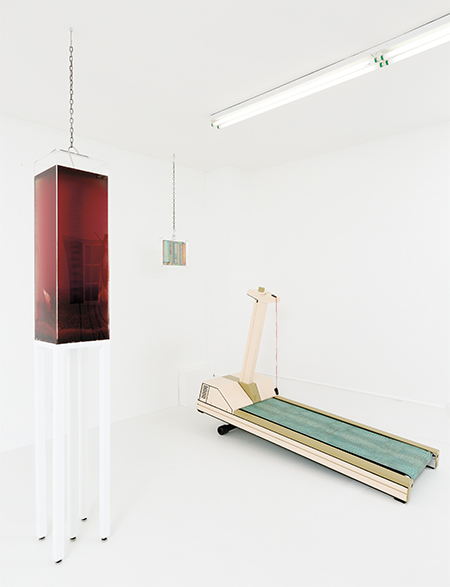In Focus: Max Hooper Schneider
Imagining a world without humans
Imagining a world without humans

Travel 12 hours by road into the Gobi desert from Ulan Bator in Mongolia and you’ll come to a section of mountain that glows. Local nomadic tribes have been using this bright spot as a beacon ever since 2012, when the artist Max Hooper Schneider coated an 8m² area of rock with phosphorescent pigment for Mineral Complex, his contribution to the 2nd Mongolia 360° Land Art Biennial; the patch of land will continue to glow for 300 years.
The following year, for Living Epoxy: Disarticulation of Delphinapterus leucas (2013), Schneider displayed the bones of a giant beluga whale, cast from photoluminescent epoxyresin, but this time aglow in the windows of a building near the Pacific Ocean in Santa Monica, Los Angeles. Schneider mixed up the bones to confuse the structure of the whale and increase the strangeness of the moment for people in the gallery and passersby on the street.

Both works promote what Schneider has termed a ‘lonely encounter with something anomalous’, which for the artist signifies both an approach to aesthetics and the philosophical question at the heart of his work. Having degrees in both biology and landscape architecture, Schneider creates worlds as though he were a renegade scientist, using his practical skills in laboratory research for fiction and art instead of empirical inquiry. Schneider distils his practice down to a single pithy dictum – ‘to un-quantify the world’ – but the artist appears to be investigating something more expansive.
Schneider imagines a world without humans, or one in which nature has been depopulated of human interests. Such strategies of art-making have received a surge of interest in the last decade, partly due to the rise in awareness of global warming. Much as during the Cold War, writers, directors, painters and artists are seeking to respond to the real possibility of an avoidable disaster, in which other surviving species make use of the old, ruined worlds.
In Schneider’s From Death Row to Purgatory, made for the 2014 Paramount Ranch art fair in Los Angeles, visitors could approach a pink casket, displayed as though at a funeral viewing. Inside, the artist had created a marine environment for creatures such as red-eared slider turtles, goldfish and crayfish. Described by Schneider as ‘faunal ready-mades because of their mass production, ubiquity and availability in virtually every pet store in the us and abroad’, the creatures lived in the casket for the duration of the fair, rescued (albeit temporarily) from near-certain death in la’s Chinatown.
Schneider framed From Death Row to Purgatory as a fictional narrative in which the rescued creatures are subject to a pre-death version of the Catholic notion of purgatory and Paramount Ranch serves as a way station on the path to the afterlife. Not only is the resulting work biology meets theatre meets sculpture, it also raises a number of questions: what does it mean for animals to occupy an object needed by humans alone? Can an artist study the boundary between the created narratives of humans and the real world of animals? What does it mean for a human to be unable to understand how the world may be experienced outside his own particular consciousness?

Schneider took this study further in ‘The Pound’, his 2014 exhibition at LA gallery Jenny’s, which presented an assortment of make-believe creatures – all hybrids of organic matter and machines. There was a treadmill cross-pollinated with a crocodile, a vintage popcorn machine turned habitat for snails, a spinal cord floating in an evaporating receptacle of blood and a watermelon in an aquarium apparently sending out its thoughts via an LCD. Alongside each specimen’s backstory, advice was displayed regarding its appropriate care: Genus Watermeloncolia, for instance, is considered ‘low risk, delusional’. Here were doomed species that needed to be saved, just as animals in a pound might. Undergirding ‘The Pound’ are nostomania and an equally obsessive desire to fill sentimental items with new life and consciousness.
Currently, Schneider is working with an old Maytag washing machine, of the kind that advertised a world of ease and optimism for a broad swathe of the general public in the wake of two world wars. It is yet to be determined what sort of world Schneider will dream up for the Maytag and which, if any, creatures will occupy its clean world of the past. What is certain, however, is the timelessness of Schneider’s message: whether it was yesterday’s Cold War anxieties or the reality of today’s rising seas, a world which goes on without humans is still a world worth studying.






















